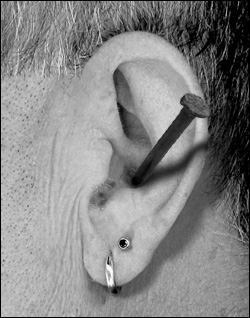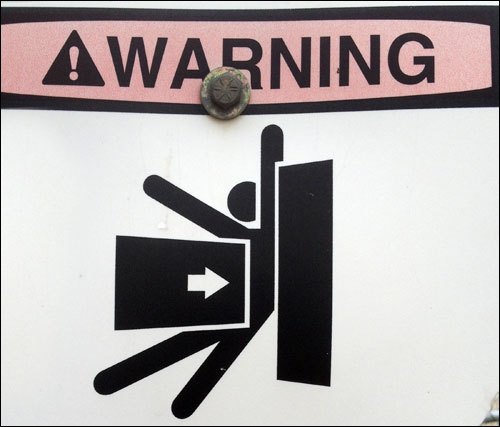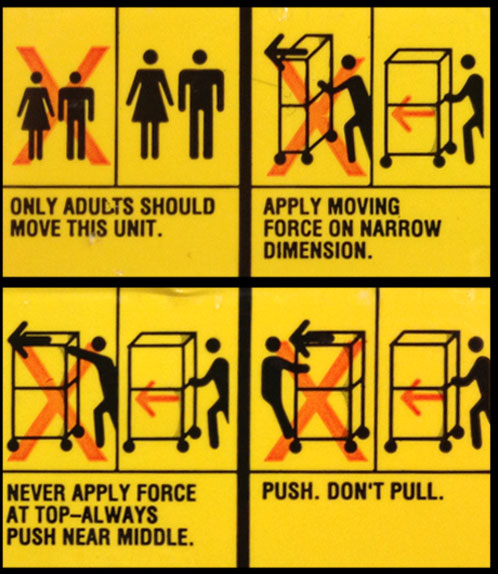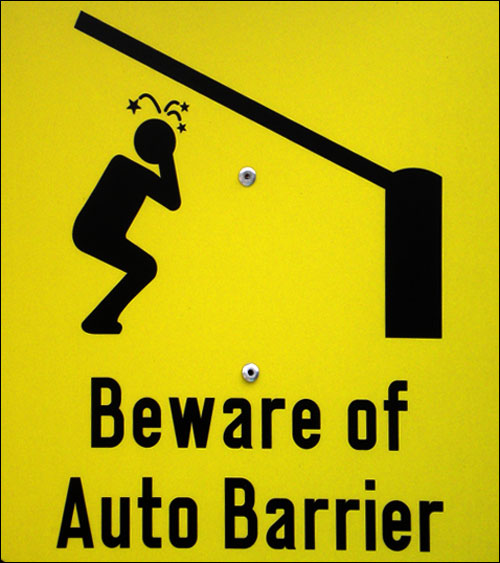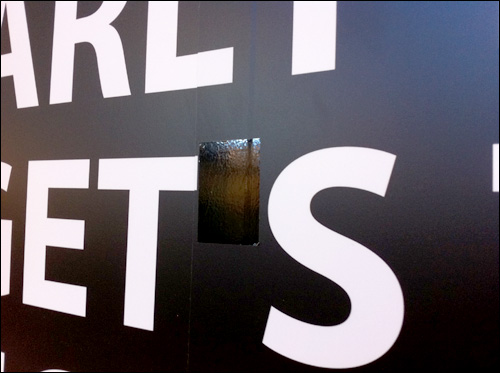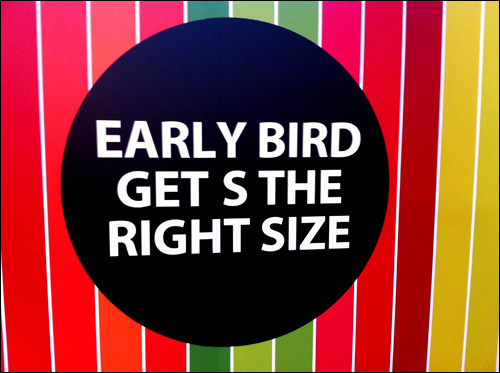Mon 30 Jan 2012
No, You Go.
Posted by anaglyph under Movies
[22] Comments
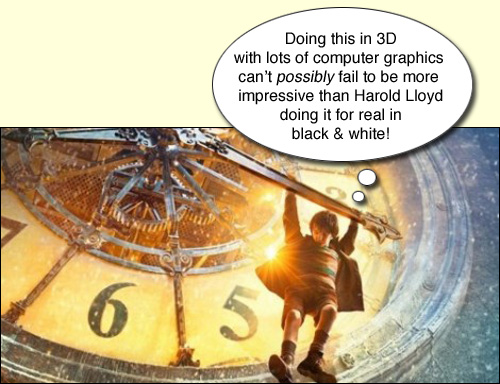
As you have no doubt already intuited, this is going to be one of my very rare movie reviews. And I’ll say it now – it’s a long one. I make no apology, because in this case, I’m really going against both critical opinion and audience acceptance (and probably the Oscar for Best Film) so you can be sure I will say controversial and entertaining things.
Yesterday I went to see Martin Scorsese’s fêted kid’s film Hugo. I made a special effort to see this film, and in 3D, because, you see I had been told two things about it (which turned out to be completely untrue): the first was that it’s ‘not really a kid’s film’, and the second that the 3D ‘is really great’.
Consequently, I will split this review into two parts, although there will inevitably be some overlapping. First, the 3D.
As many of you know, I have come to hate 3D in the movies. I didn’t always – I’ve long been a fan of the old anaglyph black & whites like ‘Creature from the Black Lagoon’ and ‘It Came from Outer Space’, and I have a fond spot for André de Toth’s seminal House of Wax and Hitchcock’s wonderful Dial M for Murder. These films, and others like them through the fifties and sixties, made admirable and necessary explorations into what seems like a logical direction for cinema to go. Unfortunately, there are many, many complications with making 3D work in the moving image domain, and those films never really conquered them. As a result, 3D was, decades ago, relegated onto a back shelf of cinema history, and despite several optimistic attempts to air it out through the 70s and 80s, it has never managed to get traction on the big screen. The difficulty in making 3D acceptable to an audience has always been blamed on the inadequacies of the technology – which is a fair criticism to a point – but as Hugo demonstrates very clearly, that’s only part of the problem.
Part of the problem it is though, and my experience with Hugo was no exception. This presentation was made using an active shutter system (XpanD, specifically) which basically entails a pair of 3D glasses that rapidly blank out alternating left/right images coming from the screen in such a way as to direct the appropriate image to the appropriate eye and so achieve stereoscopy. It is probably a superior system to the polarized X/Y axis technology (which I find supremely annoying) but only just. The first irritation became apparent as soon as the movie began – the damn glasses were greasy and dirty. So not only was I getting a dim murky image due to the attenuated luminance that 3D inflicts anyway, it was further degraded by great smears of refracted light in my peripheral vision. And try as I might, I couldn’t clean the glasses with anything I had to hand. So what – now everytime I go to the movies I have to remember to take a bottle of lens cleaner and a box of Kleenex with me? ((Later, as I left the cinema, I saw the staff frantically re-smearing all the XpanD glasses in preparation for the next show. I should have paid more attention to how they were doing this, but my eyes were still trying to adjust to seeing normally. My fleeting impression was that they were just wiping the damn things with a rag that was no doubt saturated with popcorn butter from all the glasses of the last five sessions. As with many aspects of modern cinema, the ‘advances’ in technology are mostly just creating more work for already underpaid people.)) This was almost distracting enough to make me want to leave thirty seconds into the film. When I pay $17 to see a movie, ((Violet Towne actually shouted me to this screening, so it was really her money. Sorry honey.)) I want to see the movie, not hazy tenebrous images filtered through the remnants of some kid’s hot-popcorn-butter-smudged fingerprints. Still, I had been told the 3D was ‘great’ in this film, so I persevered. I had, however, been distracted enough to miss the film’s set up. Good one 3D! Within a few minutes the major drawback of the active shutter system technology became apparent. The refresh rate of the LCD blanking technology is well below the frame rate of projected movie film, ((Unless the film is projected at a higher frame rate. Some systems are embracing a new standard speed of 48 or 60 frames per second to go some way to alleviating the refresh rate flicker problem. We shall see if that makes it any more bearable.)) and this creates an unpleasant strobing effect whenever there is a quick camera movement, or a bright, rapidly moving object in the frame. ((Moving 3D film images tend to have a problem with strobing on horizontal moving objects anyway, for very technical reasons to do with the way our brains detect rapidly moving hard edges.)) And guess what – this film has lots of falling snow. Little particles of bright 3D snow that zip and dart and STROBE across your field of vision. Horrifically distracting. And it hurts us, it hurts our eyeses, precious. Come ON, guys. Moving pictures have spent a century contriving to look fluid and seamless and now you expect us to put up with this kind of crap? To make matters worse, the opening sequences of Hugo are crammed with fast tracking sequences, fast action and rapid cutting. Scorsese flings the camera around like it’s a ball on a paddle bat. Technically speaking, for the moment 3D does not tolerate this kind of thing very well. ((And the corollary is that, for the moment, you should avoid doing it.)) It’s puzzling that Martin Scorsese, a filmmaker of extraordinary accomplishment, has not picked up on this fact.
And it’s here that I knew with absolute certainty that the 3D in this film was going to be anything but ‘great’. Oh, there’s a LOT of 3D, no question about it. Every shot is crammed with 3D-isms. There’s smoke and snow and dust and ashes and sparkles and cogs and dogs and shafts and fog and just about everything you could ask for to add visual depth to the image. It’s just a pity that it doesn’t add any other kind of depth. I can almost hear Marty screaming ‘There’s not enough 3D in that shot! More CG smoke – I don’t want them thinking I’m some kind of modern-day de Toth!’ ((André de Toth, the director of House of Wax was famously blind in one eye, so he could not actually see the 3D effect in the film. He evidently relied on the rest of his crew to make sure it was viable.)) The people who had been raving that the 3D of Hugo was ‘great’ just meant ‘there’s a lot of it’ – not unlike the people who tell me they think the sound in a movie was ‘great’ when what they actually mean is that it was ‘loud’.
Now, one of the the knock-on effects of having extravagant lashings of 3D in every shot is that your eyes want to look at stuff. In the real world this is what happens. Something moves in your field of view, you look at it. People talk, you look at them. A boat on a lake in the distance is pretty, you look at it. What never occurs in the real world, however, is that these things all take place within seconds of one another in a rapid replacement effect. There are two major catastrophic blunders that you can make with 3D, therefore, and Hugo makes them again and again and again and again.
The first is that you can’t just cut from one shot to another shot without any regard for where people’s eyes might be. In flat 2D filmmaking, we’ve spent decades honing our skills in such a way as to guide the eyes and ears of the audience in a carefully choreographed ballet of vision and sound. The art of montage – the ‘editing’ of the film – is an integral part of good filmmaking, and it’s one of the things that you study intensely as a young filmmaker. Thelma Schoonmaker, Scorsese’s editor, is an acknowledged doyen of the craft and it’s a mystery to me how the pair of them managed to hack their way through this film so badly. It’s almost as if Thelma said to Scorsese: ‘Marty, I don’t give a flying fuck about this 3D fad. I’m just cutting the film like I usually do.’ ((Like Tim Burton apparently did with Alice in Wonderland.)) The first ten minutes of the film had my eyes popping back and forward, left and right, in and out, up and down until I felt like Marty Feldman at a tennis match. No wonder people complain about 3D giving them headaches.
The puzzle here is that, again, it’s almost like the people who made this film have never bothered to watch, or learn from, the 3D films that have come before. ((I can’t believe, for instance, that Scorsese has taken nothing from Hitchcock’s masterful use of 3D in Dial M for Murder. Hitchcock only did this one film in 3D, and audiences of the time never saw it that way because – does this sound familiar? – they had tired of the 3D fad and the film was released flat to maximise its profitability. Nevertheless, he embraced the potential of the idea and absorbed it almost effortlessly into his filmic arsenal. As a result it was, and remains, one of the best uses of 3D to date, and I pine for one of the current batch of 3D advocates to come up with something half as well realised.)) 3D demands a particular kind of language just as 2D does, and you simply can’t barge into it with the same techniques that have served you in the past. For a start, it necessitates an understanding of what your eyes actually do when they look at things in the real world. The only time, for instance, that you need to snap your focus from a person talking in the middle distance to a big thing close to your face is when something extremely unexpected or confronting happens. In real life, this mostly causes you to jump backwards and knock your beer over. Now, when making a film, if it’s not your intention to smack the audience in the face like this, DON’T DO IT. And certainly don’t do it repeatedly, because the other problem here is that it makes your eyes do things they never, ever do in normal circumstances. Geez, for the first time in my life I feel like I could easily teach Martin Scorsese a thing or two about filmmaking. That should just NOT be happening.
The other appalling 3D fumble that is committed in this film, often in lock-step with the oafish cutting mentioned above, has to do with focus. This is a mistake that has been committed in every single one of the recent crop of 3D live action films ((But not with animated films. I wonder if you can work out why?)) and it makes me mad every time I see it. It’s the act of having things in the frame out of focus. Now, in 2D, we’re used to seeing this technique. It’s not a function of natural vision, but is a trick of photography, and it is used to direct the eye to something, or to throw it into relief. It works in 2D only because watching things on a 2D plane is not realistic, and so we have learned non-realistic tricks to help us make sense of the 2D image. The problem is it simply does not work in 3D. This is because – I hope you’re paying attention here Marty – we do not see things out of focus in real life! ((Unless of course we are myopic and don’t have our spectacles on. But I don’t need to tell you that no-one actually seeks out this state.))
Human vision is an amazing thing. It’s mostly amazing because only a small part of it is to do with optics. The rest has to do with a complicated system of visual processing in the brain. As far as the brain is concerned, things are only ever out of focus when there’s a problem. This is because our brain modifies our visual apparatus constantly, racking focus, pulling aperture, adjusting stereoscopic convergence, tilting and panning, and then gathering the information from this process to provide what appears to be one seamless binocular vision of our circumstances. Critically, it does this by ignoring a lot of stuff. One of the the biggest visual distractions it has learnt to ignore is anything that is out of focus. In your normal day-to-day life, you are very seldom aware of things that are out of focus.
Go on – try it now. Look around the room and try and see something in your field of view that is out of focus. You can’t do it! Whether it’s on your desk, over near the piano or out the window, your brain is constantly working overtime to make sure everything is properly focussed for you to look at. Things that it doesn’t focus on, it just doesn’t pay attention to. ((If you’re not following me here, you’ve misunderstood – as have most modern filmmakers attempting 3D – a fundamental mechanism of human vision. We do not see the world like a camera sees it. We have spent a century ‘learning’ how to see flat 2D images as portrayals of reality, but this is essentially not the way we see things in reality. Even if you have vision in only one eye, and are unable to resolve stereoscopy, you still don’t see the world like a camera does. It’s all to do with the fact that a camera is a purely optical system, and human vision is a computer-enhanced information gathering system.)) If people move in and out of your view, you can’t help but focus on them. If some fireworks go off outside, you focus on them. In fact, your world is in focus ALL THE TIME, if your brain can make it like that. And when it can’t (such as when someone thrusts a newspaper in your face and you have to step back to resolve it) you find it annoying and inconvenient. So filmmakers: WHY ARE YOU DOING IT IN 3D MOVIES? ((To try and illustrate the problem with a 2D analogy: imagine you are watching a film in a very wide anamorphic ratio – you know, Cinemascope or something. Now imagine that there are two characters talking. One thing you never do – unless you’re doing it specifically to call attention to something – is to put the two characters on the far left and right of the screen and cut between them as they talk. Why? Because the audience would be forced to snap their heads back and forth as the actors appeared first on the very left of the screen, and then on the right. It would quickly become very tiring and intrusive. We’ve evolved all kinds of film-making language to make sure that audiences aren’t popped out of the movie with irritations such as this.))
Let me give you an example of how horrible it is in Hugo ((This is just one example of many instances of it in this film – far more than I have seen in recent 3D offerings. James Cameron did it numerous times in Avatar, but only in the live action sequences. It never happens in the computer modelled scenes. I’ll leave you to reflect on why that is…)) In one scene, the eponymous Hugo and his friend Isabelle are standing in a clock tower looking out over Paris at the illuminated Eiffel Tower. The camera is behind them and tracks back. The focus is on the Eiffel Tower. The Eiffel tower is right in the centre of the frame. Hugo and Isabelle, in close foreground, are out of focus. This is irritating, but acceptable for a bit, since they are dimly lit and you are, after all, being directed to look at the bright Eiffel Tower. Then Mr Scorsese does something that is entirely acceptable – artistic and clever, even – in 2D filmmaking, but is brain-achingly stupid in 3D. He racks focus from the Eiffel Tower to our protagonists. In 2D, this would have the effect of drifting with our attention from the pretty-but-irrelevant centrepiece of the shot, back to the storyline. Movies do it all the time. So much so, that it is, indeed, a real skill to know at exactly which moment to force the focus pull in order to be in sync with the audience’s point of awareness. But CRITICALLY, this is a trick of 2D photography. In real stereoscopic human vision, we just don’t interpret the world like that, and so if someone does it in a 3D film, our brains are forced to do a very strange thing: we need to recompute the environment to try and make sense of it. In my brain, at that moment, it went something like this:
‘Oh, that’s a pretty shot of the Eiffel Tower. Weird out-of-focus people in the foreground, but whatever. Look at that beautiful model of Paris with all the lights on the Tower. I wonder if it really looked like that in the 1930s, electric light must… WHAT THE FUCK – EVERYTHING’S GONE OUT OF FOCUS. Oh. I see. I’m supposed to be looking at the actors now.’
To put it succinctly, if we were involved in this kind of scene in reality, we might look at the Tower, look at Paris, look at the kids, look back at the Tower – whatever. CRUCIALLY, nothing would ever be out of focus, especially the brightly lit BIG thing right in the middle of frame.
‘But wait just a goddamn minute!’ I hear you say. ‘It’s a movie, and movies are not reality. Movies do stylized tricky things all the time, and that’s OK! What about close-ups and Dutch tilts and zooms and stuff? They’re nothing like ‘reality’!’
Close-ups and Dutch tilts and zooms and jump cuts and a whole arsenal of cinematic hocus pocus has arisen, just like the focus rack, in the domain of the artificiality of 2D photographic image. They are techniques that ask us to make mental adjustments to the way we view a flat, already artificial, world. We simply cannot expect them to translate into a 3 dimensional space. They might, but if they don’t, we shouldn’t just go ahead and use them anyway, which is what’s happening here.
The mental disorientation with the focus shift that I’ve outlined above all happened very rapidly and quite subliminally it is true, but the significant point is that a contrivance of technique popped me straight out of the movie. As filmmakers, we spend every working moment trying to make sure that we don’t pop people out of the willing suspension of disbelief. To do so is the greatest single moviemaking crime you can commit. If we are to continue with this 3D thing we really need to find new ways to direct the attention of the audience, methods that don’t go against everything that evolution has wrought in us from the day that some mud-dwelling crustacean discovered that two eyes are better than one for avoiding being eaten. ((Lest you think I am talking out of my ass with all this stuff, consider that in my job as a professional sound designer, I have already been there. Sound people have been adjusting to spatial changes in film sound since we went from mono to stereo back in the 1940s. And now, with ‘surround sound’ we have in fact been dealing with a 3D environment for four decades. We’ve learnt a thing or two about what you can and cannot do. One thing I can tell you with absolute certainty is that many things that were totally acceptable in mono soundtracks just do not work in a full 3 dimensional spatial environment. We’ve had to learn new ways of making things work. And we’ve had to learn those new ways without making audiences hate the film because the sound hurt their ears.))
There are a dozen other types of similar terrible blunders of technique in Hugo: an extreme closeup of an eye looking through keyhole, where the keyhole is out of focus and the eye is sharp and crisp. (NO! Your eye would never see it like that! It feels WRONG because it IS wrong!); a horrible step-zoom where the focal plane changes every time a cut is made, forcing you to re-converge your eyes in a cascade of unpleasant jumps; ugly dissolves with convergence mis-alignments; ((Human eyes have a real problem with the kinds of artificial convergence thrust upon them in 3D photography. Again, this is a technical issue of human vision, and so is complicated to explain, but basically, when we look at objects we expect our eyes to refocus and re-converge stereoscopically at the same time. In the cinema, the focal plane is always constant (the screen) and the convergence is the only thing that changes. This is highly unnatural. We can do it, of course – otherwise photographic stereoscopy wouldn’t work – but it makes our eyes attempt to behave in a way that they would never naturally need to. It’s bad enough that movies force us to try to do it, but it’s MUCH worse when they make us do it rapidly and repeatedly. If you are the kind of person who feels nauseous when watching 3D, this is almost certainly why.)) rapid camera moves where you lose your point of convergence, scrabble around to find it, and give up because the shot just cut anyway; objects that are in focus in one shot and then out of focus in the subsequent shot, forcing your brain to try and make sense of why that is.
I won’t go on about it anymore – I think you get the drift. Everybody seems to be aware that 3D in the movies has to conquer many technical problems before it is a valuable (or even bearable) addition to the cinema experience, but as Scorsese’s Hugo demonstrates vividly, filmmakers themselves are probably its biggest liability. I simply don’t care to have the spectacle of stereoscopy if it hurts my brain, and I believe that this is what a great many audience members feel too, even if they can’t put their fingers on exactly why they don’t like it. I’ll raise it as a point of interest, even if I don’t know if it has any bearing on things, but I find it curious that the people who are pushing hardest for 3D, and making most of the 3D films, are largely old-guard filmmakers like Cameron and Scorsese and Spielberg and, soon, Ridley Scott. ((I admit to having a great deal of trepidation about Prometheus after sitting through Hugo. I was looking forward to seeing what both these directors did with 3D, since each was equally voluble about how much he loved it, and, in Scott’s case about how he would ‘never do another film in 2D again’. Now I just think I’m going to see the same old blunders committed over and over. I’m even inclined to see the movie first in 2D, just in case it’s actually a good movie and the 3D wrecks it for me.)) I’m not entirely sure why this should be – maybe because these guys are the only ones who can afford the technology and the budgets that warrant the extra cost of a 3D release – but what we need to see before 3D has even an ice-cube’s chance in hell of getting a foothold, is the arrival of some smart young filmmakers who can distance themselves from the ‘rules’ of conventional flat filmmaking and create a new language for stereoscopy that allows it to enhance the storytelling and emotion of a movie, rather than being the ‘next big special effect’. Until that day arrives, no amount of virtuosity in the mechanical/technical side of 3D is going to matter one whit, is my estimation.
Part 2 of this post will be coming up in a bit. If you think I hated the 3D, wait till you find out what I thought of the film itself…
